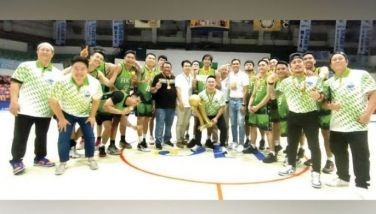No OrdinaryCarinderia
November 2, 2003 | 12:00am
Just off the girly bars of P. Burgos in Makati is Durban Street. Under the glare of Shampoo bar’s neon lights are several middle class homes. The black gate at 4890 is open. Mono-block chairs and tables are arranged for a crowd of about twenty people in the garage. There is a makeshift kitchen with two gas burners, and several saucepots rest on the table, with different viands ready.
Like any carinderia, the mismatched plastic glass tumblers are face down in a towering pile next to the water jug. Cases of softdrink bottles are piled on the floor. The plates come in all shapes and sizes. There are flimsy paper napkins to wipe your mouth, but when they run out a roll of toilet paper is on standby. A spoon is given along with some chopsticks to eat your meal. The stray cats casually strolling by are a natural occurrence in this carinderia. Nothing fancy here.
But this is no ordinary carinderia. The television set is on most of the day, but it is not showing Eat Bulaga or Game Ka Na Ba? or some Chinovela; the set is tuned instead to Arirang. Half of its customers are Koreans, the rest are a mix of Filipinos and foreigners frequenting P. Burgos. In this carinderia, you won’t find the "da-do-do" staples, referring to afritada, menudo and adobo that are the standard carinderia fare. Instead, there is authentic Korean food, freshly cooked upon ordering.
Welcome to Van’s Eatery, owned by a Korean couple, Chasook and Sang Kyu Choi. Struggling through conversation in broken English and Tagalog, it took me ten minutes to figure out who Van is: it is Chasook’s maiden name. Mr. Choi’s older sister moved to the Philippines ten years ago. She first resided in Talisay, Batangas, but now has a Korean grocery along Makati Avenue. Sang Kyu along with his wife Chasook and their son joined her in Talisay five years ago. Now, they have moved to Durban Street, Makati , with their son attending university back in Seoul, Korea.
Mr. Choi had been working in a Korean restaurant in Seoul for 25 years. With his cooking experience, he opened a restaurant along P. Burgos. Taking the cue from Filipinos, he deemed it best to cook and serve it from his house. He seems to have gained inspiration from the carinderia next door with a similar set-up serving Filipino standard fare. Opening just three months ago, people are starting to take notice of Van’s.
The couple is very friendly and accommodating, but conducting some semblance of an interview was difficult with their limited skills in English and Tagalog. But they communicated well in a language I easily understand–food. On our first visit, my friends Carlo and Jong and I had a feast. We stared at the menu written on two sheets of white cartolina, the black ink beginning to fade, the handwriting uneven.
We started out with the Special Soup Noodle. While its name seems so plain in English, this soup is served at weddings and other special occasions in Korea. The broth was tasty with a subtle spiciness. Van served us a bowl of Water Kimchi to sample. Instead of the fiery orange-colored kimchi we are accustomed to, the cabbage was soaking in a clear liquid, the flavor less spicy and somewhat refreshing to the palate. Jabche or Chapchae is stir-fried glass noodles cooked with meat and vegetables with a hint of sweetness and spiciness.
With the hot chili flavor whetting our appetites, we consumed several servings of rice with our Spicy Pork Bulgogi and Galbizim or Kalbichim (beef stew). Mr. Choi kindly satisfied my curiosity about the beverage in green bottles stored in his chiller, letting me sample the Korean drink for free. Its potent alcohol punch is reminiscent of lambanog with a strong cucumber flavor.
Jong and I found our selves sitting on the monoblock chairs again two weeks later. Jong admitted this is his fourth visit; he tasted the Bimbimbop just two nights past. When we arrived, Chasook was making kimchi in a bowl as large as a laundry basin. She makes this every three days, since her Korean customers eat this fiery condiment with every meal. While kimchi is usually made during the autumn months to last through winter in Korea, here in the Philippines kimchi can be made all year round.
Chasook served us seaweed soup on the house, explaining that the soup is very nutritious. It is common practice for new mothers to drink this soup for a month after giving birth. But even non-mothers like Jong and myself enjoyed its soothing flavor, noting its similarity to miso soup. Chasook tells us the dark green seaweed is imported from Korea.
Seeing the massive bowl of kimchi being prepared, we order the Fried Kimchi Rice. Bold in flavor and savory, it could be a meal on its own. The Beef Bulgogi seemed to taste even better than the pork we sampled weeks ago. The Mixed Noodle with Beef and Vegetables seemed sweet at first but the fiery chili paste caught on after every bite.
On my first visit to Van’s Eatery, a Korean customer was eating with one leg folded up, his foot resting on the chair–not the most glamorous pose, but admittedly the most comfortable position to eat in–totally focused on his food, expertly devoured chopsticks. Now if I could only forget my inhibitions and do as this Korean did, totally lost in the delicious food this not so ordinary carinderia serves.
Like any carinderia, the mismatched plastic glass tumblers are face down in a towering pile next to the water jug. Cases of softdrink bottles are piled on the floor. The plates come in all shapes and sizes. There are flimsy paper napkins to wipe your mouth, but when they run out a roll of toilet paper is on standby. A spoon is given along with some chopsticks to eat your meal. The stray cats casually strolling by are a natural occurrence in this carinderia. Nothing fancy here.
But this is no ordinary carinderia. The television set is on most of the day, but it is not showing Eat Bulaga or Game Ka Na Ba? or some Chinovela; the set is tuned instead to Arirang. Half of its customers are Koreans, the rest are a mix of Filipinos and foreigners frequenting P. Burgos. In this carinderia, you won’t find the "da-do-do" staples, referring to afritada, menudo and adobo that are the standard carinderia fare. Instead, there is authentic Korean food, freshly cooked upon ordering.
Welcome to Van’s Eatery, owned by a Korean couple, Chasook and Sang Kyu Choi. Struggling through conversation in broken English and Tagalog, it took me ten minutes to figure out who Van is: it is Chasook’s maiden name. Mr. Choi’s older sister moved to the Philippines ten years ago. She first resided in Talisay, Batangas, but now has a Korean grocery along Makati Avenue. Sang Kyu along with his wife Chasook and their son joined her in Talisay five years ago. Now, they have moved to Durban Street, Makati , with their son attending university back in Seoul, Korea.
Mr. Choi had been working in a Korean restaurant in Seoul for 25 years. With his cooking experience, he opened a restaurant along P. Burgos. Taking the cue from Filipinos, he deemed it best to cook and serve it from his house. He seems to have gained inspiration from the carinderia next door with a similar set-up serving Filipino standard fare. Opening just three months ago, people are starting to take notice of Van’s.
The couple is very friendly and accommodating, but conducting some semblance of an interview was difficult with their limited skills in English and Tagalog. But they communicated well in a language I easily understand–food. On our first visit, my friends Carlo and Jong and I had a feast. We stared at the menu written on two sheets of white cartolina, the black ink beginning to fade, the handwriting uneven.
We started out with the Special Soup Noodle. While its name seems so plain in English, this soup is served at weddings and other special occasions in Korea. The broth was tasty with a subtle spiciness. Van served us a bowl of Water Kimchi to sample. Instead of the fiery orange-colored kimchi we are accustomed to, the cabbage was soaking in a clear liquid, the flavor less spicy and somewhat refreshing to the palate. Jabche or Chapchae is stir-fried glass noodles cooked with meat and vegetables with a hint of sweetness and spiciness.
With the hot chili flavor whetting our appetites, we consumed several servings of rice with our Spicy Pork Bulgogi and Galbizim or Kalbichim (beef stew). Mr. Choi kindly satisfied my curiosity about the beverage in green bottles stored in his chiller, letting me sample the Korean drink for free. Its potent alcohol punch is reminiscent of lambanog with a strong cucumber flavor.
Jong and I found our selves sitting on the monoblock chairs again two weeks later. Jong admitted this is his fourth visit; he tasted the Bimbimbop just two nights past. When we arrived, Chasook was making kimchi in a bowl as large as a laundry basin. She makes this every three days, since her Korean customers eat this fiery condiment with every meal. While kimchi is usually made during the autumn months to last through winter in Korea, here in the Philippines kimchi can be made all year round.
Chasook served us seaweed soup on the house, explaining that the soup is very nutritious. It is common practice for new mothers to drink this soup for a month after giving birth. But even non-mothers like Jong and myself enjoyed its soothing flavor, noting its similarity to miso soup. Chasook tells us the dark green seaweed is imported from Korea.
Seeing the massive bowl of kimchi being prepared, we order the Fried Kimchi Rice. Bold in flavor and savory, it could be a meal on its own. The Beef Bulgogi seemed to taste even better than the pork we sampled weeks ago. The Mixed Noodle with Beef and Vegetables seemed sweet at first but the fiery chili paste caught on after every bite.
On my first visit to Van’s Eatery, a Korean customer was eating with one leg folded up, his foot resting on the chair–not the most glamorous pose, but admittedly the most comfortable position to eat in–totally focused on his food, expertly devoured chopsticks. Now if I could only forget my inhibitions and do as this Korean did, totally lost in the delicious food this not so ordinary carinderia serves.
BrandSpace Articles
<
>
- Latest
- Trending
Trending
Latest
Trending
Latest
Recommended
January 30, 2025 - 12:00am
January 29, 2025 - 12:00am
















